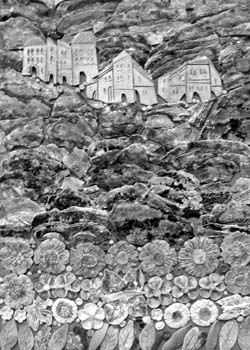Creative instinct
Pecherska Art Gallery hosts exhibit of noted Ukrainian artist Vira Tomashevska
Ceramics are the oldest form of figurative art; impressions of human hands found on clay objects are early man’s first attempt to vanquish time. No other material appeals to man’s creative instinct to the same degree; nor is it coincidental that a number of mystical systems compare the supreme deity to a potter, who creates a human image out of clay. Ceramics are one of the creative archetypes, so ceramic pieces look most organic when they portray images from the distant past or those that are dictated by an artist’s concept of primeval integrity of harmony. Attesting to this and many other ordinary discourses on ceramics is Vira Tomashevska’s exhibit.
The artist was born in Zakarpattia. She completed her primary art education in Liudmyla Averkiyeva’s class in Uzhhorod’s College of Applied Art, whose professional level matches Lviv’s celebrated decorative-applied art workshops. After graduating in 1975, Tomashevska studied at the Art History Faculty of the former Kyiv State Art Institute (today the Academy of Pictorial Art and Architecture). The artist has taken part in international and regional plein-air shows and exhibits for a number of years.
Tomashevska specializes in small-format panels resembling colorful miniature carpets. She works with a potter’s wheel, combining ordinary and double-firing details as well as molten glass.
At the moment, creating a monumental work to embellish a large building is more of the artist’s dream than a concrete plan. However, instead of wasting time because of a lack of state commissions that most masters of monumental ceramics stopped receiving after the fall of the USSR, Tomashevska focused on creating small ceramic panels, compositions about 1 square meter in size that look good with or without a frame; their neutral backgrounds seem to merge with walls, which makes the muted color relief look even brighter.
The artist’s composition technique is a complex combination of small, flat ceramic figures on the surface of a canvas fixed on a rigid plane-table. Figurative elements — blossoming trees, small houses, birds, human figures — are created, painted, and fired separately, then placed on small planes in keeping with the artist’s concept. Solitary houses glued to the surface turn into towns, and another layer complements the narrow and packed streets with a smattering of blooming trees (the diptych “Summer Town”). The use of a composite technique allows her to combine in the space of a single canvas several kinds of ceramics: white, red, and pink clay at various stages of firing, as well as molten, colored glass (e.g., “Winter”). The colorful pictures are composed of rough surfaces that have gone through only the first firing stage, as well as smooth, shiny icy-looking surfaces of figures after the second firing, with colorless or colored glazing. Sometimes a smooth, shiny strip embellishes the center of a petal or a small house, with the edges left rough. This produces a very interesting and eye-pleasing effect.
Tomashevska’s themes are markedly diversified: seasons of the year, towns (e.g., “Distant Islands,” “Landscape”), birds (“Summer,” “The Whirlpool”), fish (“The Sales,” “Fish”), Carpathian landscapes (“Verkhovynians,” “Karpaty”), flowers (“Bouquet,” “Sunflowers”), the Mask series, and works illustrating abstract notions (“Movement”). A decorative panel is easily visualized in practically any rustically stylized interior, invariably in the nursery, or ideally anywhere in an area densely populated by children, like a daycare center or elementary school. Tomashevska’s ceramic pieces contain no ideology whatsoever; her works of art are simple, attractive, and understandable, like a wonderful fairy tale.
These works of art are straightforward and sincere. Her little buildings, fish, trees, orchards, and mustachioed Hutsuls, featuring warm ceramic colors, are like illustrations for a children’s book with all the pages open at the same time. Tomashevska’s fairy tales are told one after the other, with different settings and characters, but with the main hero, the viewer, remaining in the artist’s special and cozy children’s wonder-world. The viewer is surprised to discover that s/he feels at home there. This wonder-world is quiet and comfortable, despite the adult age of the actual world outside the art gallery, with the fatigue and other “joys” of life in a megalopolis. We lack what we usually place in the rooms where our children live; we lack children’s memories with their straightforward simplicity, rich colors, and fresh concepts. Tomashevska’s ceramic creations are precisely this: sincere and straightforward bestowed on us through talent and professionalism.
Newspaper output №:
№41, (2005)Section
Time Out





